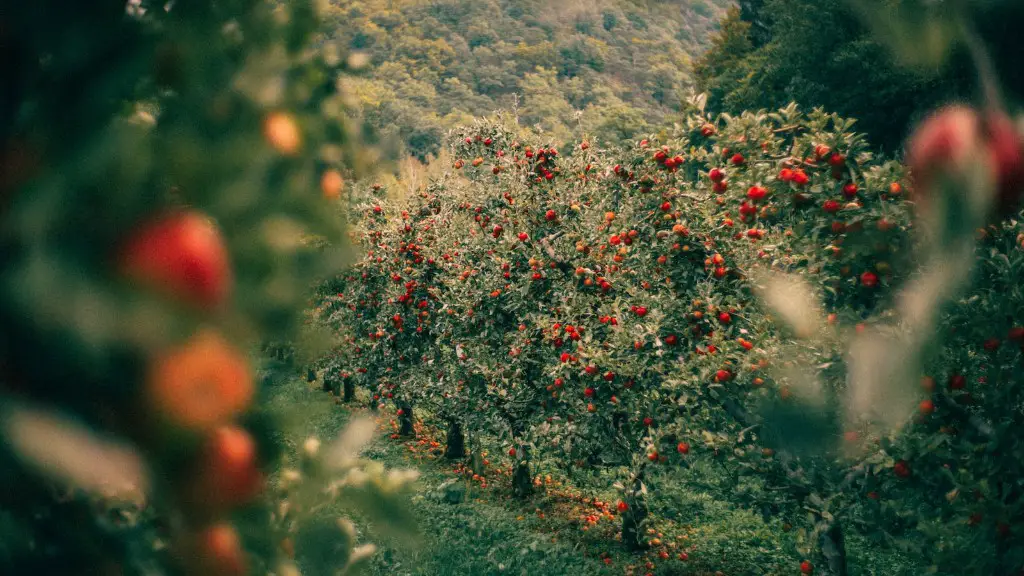Many gardeners are seeing yellow spots on their apple tree leaves and are wondering what is causing them. The most common cause of this issue is a fungal infection called cedar apple rust. The fungus is spread by the juniper and cedar trees found near apple orchards and can cause even severe defoliation if left unchecked. Rust fungus may appear as raised spots, yellow spots, or a yellow powder on the leaves. It can also cause the leaves to curl, and can be seen on the apple fruit.
The rust fungus overwinters in the juniper or cedar trees and then releases spores in the mid-spring. These spores travel to the apple tree leaves and form small yellow spots. As the season passes, these spots become more yellow, and eventually a dry, powdery substance is formed which is the rust disease itself. Once the rust fungus has established itself on the leaves, it is more difficult to get rid of. If the infection remains untreated, it can severely reduce the productivity of the apple tree.
To prevent cedar apple rust, it is important to remove the infected leaves as soon as possible and treat the apple tree with a fungicide. It is also important to prune any juniper or cedar trees near the apple orchard and there are fungicides available that can be sprayed on both the apple tree and the junipers or cedars to prevent infection. Removal of the infected yellow spots and regular fungicide treatment throughout the season are the most effective methods for preventing the spread of this disease.
Additionally, gardeners should also consider using a sulfur-based fungicide, as sulfur has been found to be an effective preventative treatment against cedar apple rust. Although sulfur-based fungicides can be applied as a soil drench or foliar spray, foliar applications on the leaves of the apple tree are the most effective way to protect the tree against the fungus. Additionally, it is important to keep the apple tree well-maintained and carefully monitor for signs of infection.
Using appropriate preventative measures and a prompt response to cedar apple rust when it occurs are the best ways to protect the health of the apple tree and preserve the productivity of the crop. By following these steps, gardeners can enjoy a healthy apple tree and a bountiful harvest for years to come.
Preventing Cedar Apple Rust
Preventing cedar apple rust is critical to keeping apple trees healthy and productive. One of the most important preventive measures is to prune any nearby juniper or cedar trees. Cutting away branches that may be touching the apple tree and reducing the amount of foliage around the tree can reduce the risk of infection. In addition, it is also important to keep the apple tree well-maintained with proper fertilization and regular pruning.
Fungicides can also be used to prevent cedar apple rust on apple trees. Sulfur-based fungicides have been identified as effective preventatives against the disease, and are typically applied as a foliar spray. Spraying the leaves of an apple tree with a sulfur-based fungicide in the spring before the disease cycle is established can help protect the tree against this fungal infection.
In addition to fungicides, chemical modifications to the growing environment of an apple tree may also reduce the risk of infection. Moisture levels should be monitored, as infection can occur if the soil remains wet. Additionally, if the apple tree is located in an area with frequent rains or heavy humidity, a fungicide can be utilized more often to protect the tree from the moist environment.
Finally, it is important to inspect apple trees regularly for cedar apple rust so that any signs of infection can be caught early. Yellow spots on the leaves and a powdery yellow substance on the apple fruit are common indicators of the rust fungus, and these should be addressed immediately to prevent further damage.
Diagnosing Cedar Apple Rust
Diagnosing cedar apple rust can be difficult, as the symptoms may mimic other common diseases. The most common indication of infection is the appearance of small, yellow spots on the apple tree leaves. These spots may be raised, and they can become even more pronounced in the warm spring and summer months.
The rust fungus itself may also be visible in the form of a yellow, powder-like substance on the infected leaves. This powdery substance is composed of the fungal spores, which are released by the tree and can travel over long distances to spread the disease to other apple trees. In some cases, the rust fungus may also appear as streaks on the fruit of the apple tree.
In cases where cedar apple rust is suspected, it is important to inspect the nearby juniper or cedar trees for signs of the disease as well. The rust fungus overwinters in these trees and is then spread to apple trees when the spores are released in the mid-spring. Additionally, the yellow, powdery substance seen on the leaves of the apple tree may be a clue that the rust fungus is present and needs to be treated.
If cedar apple rust is suspected, it is important to seek out a professional for a proper diagnosis. A qualified arborist or tree care specialist can provide an accurate diagnosis and help develop an appropriate treatment plan to get rid of the disease.
Treating Cedar Apple Rust
Treating cedar apple rust when it occurs is important to prevent further infection and maintain the health of the apple tree. Once the disease is detected, it is important to act quickly and remove any infected leaves from the tree. This will help to stop the spread of the fungus and reduce damage to the tree.
Fungicides are also an effective way to treat cedar apple rust. These fungicides come in two forms: contact fungicides and systemic fungicides. Contact fungicides are sprayed directly on the leaves and bark of the tree and are effective in killing the rust fungus on contact. Systemic fungicides, however, are taken up by the tree through the roots and can protect the tree from infection for several weeks.
In addition to fungicides, sulfur has also been identified as an effective treatment for cedar apple rust. This is typically applied as a foliar spray and works by taking advantage of the sulfur’s natural antifungal properties. This can be an effective method of killing the rust fungus and preventing further infection.
Ultimately, it is important to use a combination of removal of infected leaves and a prompt response with an appropriate fungicide or sulfur-based spray in order to effectively treat cedar apple rust. This will help to maintain the health of the apple tree and maximize productivity throughout the season.
Organic Solutions to Treat Cedar Apple Rust
Gardeners who prefer organic solutions may consider using a homemade solution to address cedar apple rust. One of the most common solutions is to mix 1 cup of baking soda with 1 gallon of water and apply it to the leaves of the apple tree. This mixture is a natural fungicide and can be used to kill the rust fungus on contact.
Garlic is also a popular, organic solution to cedar apple rust. Mixing a few cloves of garlic with water and spraying the solution onto the leaves of the apple tree can help to kill the fungus and reduce its spread. The oils in garlic also have natural antifungal properties that can help prevent further infection.
Finally, neem oil is another organic solution for cedar apple rust. This natural oil has been found to be effective in killing the rust fungus and can also reduce the spread of infection. Neem oil can be purchased online or at many garden centers, and it is typically applied directly to the leaves of an apple tree.
Organic solutions can be a safe and effective way of treating cedar apple rust. However, it is important to remember that these methods are not as reliable as conventional treatments and may not be as effective in preventing the disease from spreading.
Conclusion
Cedar apple rust is a fungal infection that can cause severe defoliation and damage to apple trees if left untreated. To prevent the spread of this disease, gardeners should prune any juniper or cedar trees near the apple orchard, use a sulfur-based fungicide, monitor moisture levels, and inspect apple trees regularly for signs of infection. If cedar apple rust is detected, it is important to act quickly and remove the infected leaves, as well as treat the tree with a fungicide or sulfur-based spray.
Organic solutions such as baking soda, garlic, and neem oil may also be effective in treating cedar apple rust. However, these methods are not as reliable as conventional treatments and may not be as effective in preventing the spread of infection. Ultimately, it is important to take the necessary preventative steps and follow a prompt response in order to protect the health of the apple tree and preserve its productivity.




